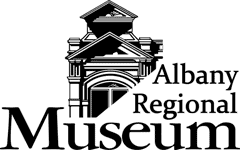By Cathy Ingalls Albany Regional Museum Board Member
Wondering who lived in your house before you did? Want to find out if a family will was recorded in Linn County between 1893 and 1978, or do you want to know why Camp Adair was built?
The answers to those questions and others that might be on your mind about our area or the people who lived here could be available in the Rod & Marty Tripp Research Room at the Albany Regional Museum.
Genealogical materials, however, are not kept in the library.
The research section is open to the public at no cost during museum business hours, or sometimes for a small fee, staff can do the looking for you if going to the museum is inconvenient.
The room on the museum’s main floor contains a wide variety of materials to assist with inquiries.
One of the compilations Executive Director Keith Lohse’s finds most interesting and helpful are the bound volumes filled with Linn court documents, including probate files, letters of guardianship, wills and marriages.
Linn County transferred the paper versions to the museum when it digitalized its records several years ago, he said.
His other favorite go-to reference that he says is packed with information about Albany is the collection of Sanborn Fire Insurance Maps.
The maps depict the commercial, industrial and residential sections of the city. They were designed to assist fire insurance agents in determining the degree of hazards associated with a certain property. For that reason, they indicate the size, shape and construction of dwellings as well as delineate firewalls, locations of windows, doors, sprinkler systems and they list types of roofs.
The maps also indicate the width and names of streets, show property boundaries, note the use of buildings, and record house and block numbers.
In a similar vein, researchers can view a list of all of the fire and ambulance runs made by the Albany Fire Department from 1917-88.
Amy Bozorth, the museum’s collections and exhibits manager, has “two volunteers inventorying the reference room just to see what’s in it. I would eventually like to make the room a resource for researchers exploring Albany, Linn County and Oregon history, but the project is in very early stages of development and won’t be completed for some time yet,” she said.
Currently, Bozorth said volunteer Charlotte Powell continually adds to the library’s collection during her weekly visits to clip and file relevant stories from the Albany Democrat-Herald.
Besides articles that appear in the DH, which are kept by subject in a file cabinet, there are stories about Albany and the surrounding area in editions of The Greater Oregon newspaper published between 1929 and 1977.
Lined up on the research shelves are student annuals for Oregon State, West Albany High School, South Albany High School, and Albany College.
In another place, there is information about the rare metals industry, particularly Teledyne Wah Chang, including staff resumes.
Bob Potts’s Remembering When books containing photos of Albany are on hand along with information about Oregon pioneers, local oral and written histories, Lewis McArthur’s guide to Oregon Geographic Names, and a book about the history of Linn-Benton Community College
There also are city directories, Albany phone books and copies of the museum’s newsletters.
In file cabinets, are biographies of well-known past and present people and information about buildings, churches, parks, civil defense, the Kalapuya Indians, field burning, hospitals, schools, veterans, parades and the now defunct but long-running Albany Timber Carnival.
Also on the shelves are volumes from 1901-2008 of the Oregon Historical Society’s historical quarterlies.
It will be up to Bozorth to figure out whether to keep or pass along a hodge-podge of items, including a series of books that tell the history of World War II, a book about ancient Oregon volcanoes, and pamphlets detailing the encampments of the Grand Army of the Republic from 1913-19.
Some of the items on the research shelves will at some point be replaced with materials now in storage on the museum’s second floor.
The research room is named for the Tripps because they gave money to help facilitate the sale of the former hardware store for use as a museum. The family also provides money to the museum each year.
To honor the Tripps, Jeff Senders designed and donated a stained glass window containing the Tripps’ names that sits above the entrance to the library.
The museum is located at 136 Lyon St. S and is open from 11 a.m. to 4 p.m. Tuesday through Friday and from 10 a.m. to 2 p.m. Saturday.
The phone number is 541-967-7122, and the website address is www.armuseum.com.

